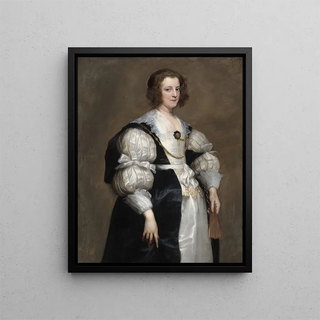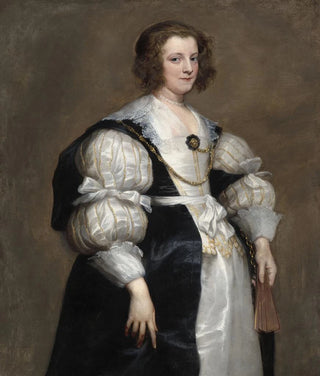Art print | Lady with a Fan - Antoine van Dyck


View from behind

Frame (optional)
Reproduction Dame à l'éventail - Antoine van Dyck – Captivating Introduction
The "Dame à l'éventail," an iconic art print by Antoine van Dyck, stands as a true masterpiece of Baroque painting. Capturing the essence of an era where elegance and sophistication reached their zenith, this canvas invites viewers to immerse themselves in a world of refinement and beauty. The protagonist, dressed in a sumptuous gown, holds an art print that seems both an accessory and a symbol of her status. This work does not merely depict a female figure; it evokes an atmosphere, a story, and a way of life that transcend centuries. Through the finesse of details and the delicacy of colors, van Dyck succeeds in immortalizing the timeless elegance of his model, while offering a reflection on the role of women in 17th-century aristocratic society.
Style and uniqueness of the work
The style of the "Dame à l'éventail" is characterized by an exceptional mastery of light and shadow, typical of the Baroque. Van Dyck uses subtle contrasts to bring his subject to life, creating a depth and dimension that seem almost tangible. The drapery of the gown, rendered with remarkable precision, reveals not only the artist's talent but also a deep understanding of textures. The art print, a central element of the composition, becomes a narrative tool, emphasizing the mystery and grace of the depicted woman. The color palette, delicate and nuanced, gives the work a soft, dreamlike atmosphere, while highlighting the beauty of the model. This piece is not merely a simple representation; it embodies an artistic vision where every detail is designed to captivate and delight.
The artist and his influence
Antoine van Dyck, a pupil of Rubens, established himself as one of the most influential portraitists of his time. His career, marked by travels across Europe, allowed him to absorb various artistic influences, which he then integrated into his own style. Van Dyck revolutionized portraiture by infusing it with a psychological dimension, capturing not only the external appearance of

Matte finish

View from behind

Frame (optional)
Reproduction Dame à l'éventail - Antoine van Dyck – Captivating Introduction
The "Dame à l'éventail," an iconic art print by Antoine van Dyck, stands as a true masterpiece of Baroque painting. Capturing the essence of an era where elegance and sophistication reached their zenith, this canvas invites viewers to immerse themselves in a world of refinement and beauty. The protagonist, dressed in a sumptuous gown, holds an art print that seems both an accessory and a symbol of her status. This work does not merely depict a female figure; it evokes an atmosphere, a story, and a way of life that transcend centuries. Through the finesse of details and the delicacy of colors, van Dyck succeeds in immortalizing the timeless elegance of his model, while offering a reflection on the role of women in 17th-century aristocratic society.
Style and uniqueness of the work
The style of the "Dame à l'éventail" is characterized by an exceptional mastery of light and shadow, typical of the Baroque. Van Dyck uses subtle contrasts to bring his subject to life, creating a depth and dimension that seem almost tangible. The drapery of the gown, rendered with remarkable precision, reveals not only the artist's talent but also a deep understanding of textures. The art print, a central element of the composition, becomes a narrative tool, emphasizing the mystery and grace of the depicted woman. The color palette, delicate and nuanced, gives the work a soft, dreamlike atmosphere, while highlighting the beauty of the model. This piece is not merely a simple representation; it embodies an artistic vision where every detail is designed to captivate and delight.
The artist and his influence
Antoine van Dyck, a pupil of Rubens, established himself as one of the most influential portraitists of his time. His career, marked by travels across Europe, allowed him to absorb various artistic influences, which he then integrated into his own style. Van Dyck revolutionized portraiture by infusing it with a psychological dimension, capturing not only the external appearance of






